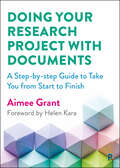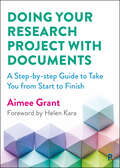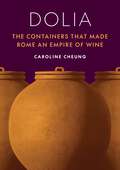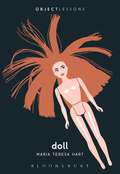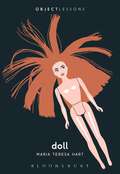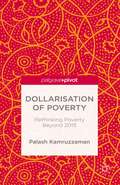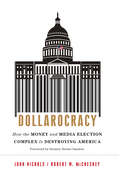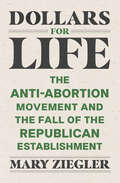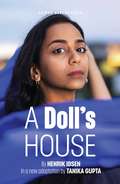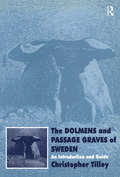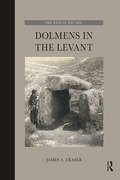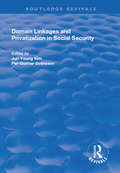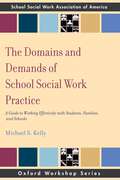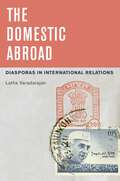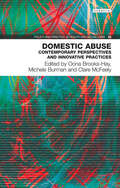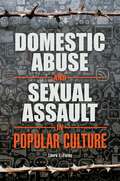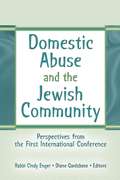- Table View
- List View
Doing Your Research Project with Documents: A Step-by-Step Guide to Take You from Start to Finish
by Aimee GrantStudents and researchers have an abundance of materials and sources available to them via the internet for use in their projects. However, there is little practical guidance available on the fundamentals of performing qualitative research with documents. This valuable book enables readers to undertake high-quality, robust research using documents as data. Encouraging critical consideration of research design, the book guides readers step-by-step through the process of planning and undertaking a research project based on documentary analysis. It covers selecting a research topic and sample through to analysing and writing up the data. The book includes: • a wealth of case studies demonstrating how lessons can be applied in practice; • summary boxes and suggestions for further reading in each chapter to guide learning; • helpful online resources to facilitate designing your own research. Accessible and comprehensive, this book will be invaluable for both students and researchers alike who are new to documentary analysis. All the Resources included in this book are available to download on the book’s webpage at https://policy.bristoluniversitypress.co.uk/doing-your-research-project-with-documents/online-resources. Look for the Online Resources logo throughout the book.
Doing Your Research Project with Documents: A Step-by-Step Guide to Take You from Start to Finish
by Aimee GrantStudents and researchers have an abundance of materials and sources available to them via the internet for use in their projects. However, there is little practical guidance available on the fundamentals of performing qualitative research with documents. This valuable book enables readers to undertake high-quality, robust research using documents as data. Encouraging critical consideration of research design, the book guides readers step-by-step through the process of planning and undertaking a research project based on documentary analysis. It covers selecting a research topic and sample through to analysing and writing up the data. The book includes: • a wealth of case studies demonstrating how lessons can be applied in practice; • summary boxes and suggestions for further reading in each chapter to guide learning; • helpful online resources to facilitate designing your own research. Accessible and comprehensive, this book will be invaluable for both students and researchers alike who are new to documentary analysis. All the Resources included in this book are available to download on the book’s webpage at https://policy.bristoluniversitypress.co.uk/doing-your-research-project-with-documents/online-resources. Look for the Online Resources logo throughout the book.
Dokumentarische Gefüge: Relationalitäten und ihre Aushandlungen (Das Dokumentarische. Exzess und Entzug #8)
by Tabea Braun Felix Hüttemann Robin Schrade Leonie ZilchWie wird Wirklichkeit erfasst und Wissen organisiert? Im Rahmen von dokumentarischen Praktiken werden diese Frage und die damit verbundenen Machtdynamiken immer wieder ausgehandelt. Die Beiträger*innen bestimmen aus interdisziplinärer Perspektive dokumentarische Gefüge als temporäre, spontane und dynamische Relationalitäten, über die nicht-linear, nicht-hierarchisch und nicht-patriarchal nachgedacht wird. Damit verweisen sie auf Beziehungen, Situationen und (Problem-)Lagen des Dokumentarischen, die sich als Intensitäten von Lebensverhältnissen, Wissensorganisationen, Umgebungen oder Infrastrukturen verstehen lassen.
Dolia: The Containers That Made Rome an Empire of Wine
by Caroline CheungThe story of the Roman Empire’s enormous wine industry told through the remarkable ceramic storage and shipping containers that made it possibleThe average resident of ancient Rome drank two-hundred-and-fifty liters of wine a year, almost a bottle a day, and the total annual volume of wine consumed in the imperial capital would have overflowed the Pantheon. But Rome was too densely developed and populated to produce its own food, let alone wine. How were the Romans able to get so much wine? The key was the dolium—the ancient world’s largest type of ceramic wine and food storage and shipping container, some of which could hold as much as two-thousand liters. In Dolia, classicist and archaeologist Caroline Cheung tells the story of these vessels—from their emergence and evolution to their major impact on trade and their eventual disappearance.Drawing on new archaeological discoveries and unpublished material, Dolia uncovers the industrial and technological developments, the wide variety of workers and skills, and the investments behind the Roman wine trade. As the trade expanded, potters developed new techniques to build large, standardized dolia for bulk fermentation, storage, and shipment. Dolia not only determined the quantity of wine produced but also influenced its quality, becoming the backbone of the trade. As dolia swept across the Mediterranean and brought wine from the far reaches of the empire to the capital’s doorstep, these vessels also drove economic growth—from rural vineyards and ceramic workshops to the wine shops of Rome.Placing these unique containers at the center of the story, Dolia is a groundbreaking account of the Roman Empire’s Mediterranean-wide wine industry.
Dolia: The Containers That Made Rome an Empire of Wine
by Caroline CheungThe story of the Roman Empire’s enormous wine industry told through the remarkable ceramic storage and shipping containers that made it possibleThe average resident of ancient Rome drank two-hundred-and-fifty liters of wine a year, almost a bottle a day, and the total annual volume of wine consumed in the imperial capital would have overflowed the Pantheon. But Rome was too densely developed and populated to produce its own food, let alone wine. How were the Romans able to get so much wine? The key was the dolium—the ancient world’s largest type of ceramic wine and food storage and shipping container, some of which could hold as much as two-thousand liters. In Dolia, classicist and archaeologist Caroline Cheung tells the story of these vessels—from their emergence and evolution to their major impact on trade and their eventual disappearance.Drawing on new archaeological discoveries and unpublished material, Dolia uncovers the industrial and technological developments, the wide variety of workers and skills, and the investments behind the Roman wine trade. As the trade expanded, potters developed new techniques to build large, standardized dolia for bulk fermentation, storage, and shipment. Dolia not only determined the quantity of wine produced but also influenced its quality, becoming the backbone of the trade. As dolia swept across the Mediterranean and brought wine from the far reaches of the empire to the capital’s doorstep, these vessels also drove economic growth—from rural vineyards and ceramic workshops to the wine shops of Rome.Placing these unique containers at the center of the story, Dolia is a groundbreaking account of the Roman Empire’s Mediterranean-wide wine industry.
Doll (Object Lessons)
by Maria Teresa HartObject Lessons is a series of short, beautifully designed books about the hidden lives of ordinary things.The haunted doll has long been a trope in horror movies, but like many fears, there is some truth at its heart. Dolls are possessed-by our aspirations. They're commonly used as a tool to teach mothering to young girls, but more often they are avatars of the idealized feminine self. (The word "doll" even acts as shorthand for a desirable woman.) They instruct girls what to strive for in society, reinforcing dominant patriarchal, heteronormative, white views around class, bodies, history, and celebrity, in insidious ways. Girls' dolls occupy the opposite space of boys' action figures, which represent masculinity, authority, warfare, and conflict. By analyzing dolls from 17th century Japanese Hinamatsuri festivals, to the '80s American Girl Dolls, and even to today's bitmoji, “Doll” reveals how the objects society encourages us to play with as girls shape the women we become.Object Lessons is published in partnership with an essay series in The Atlantic.
Doll (Object Lessons)
by Maria Teresa HartObject Lessons is a series of short, beautifully designed books about the hidden lives of ordinary things.The haunted doll has long been a trope in horror movies, but like many fears, there is some truth at its heart. Dolls are possessed-by our aspirations. They're commonly used as a tool to teach mothering to young girls, but more often they are avatars of the idealized feminine self. (The word "doll" even acts as shorthand for a desirable woman.) They instruct girls what to strive for in society, reinforcing dominant patriarchal, heteronormative, white views around class, bodies, history, and celebrity, in insidious ways. Girls' dolls occupy the opposite space of boys' action figures, which represent masculinity, authority, warfare, and conflict. By analyzing dolls from 17th century Japanese Hinamatsuri festivals, to the '80s American Girl Dolls, and even to today's bitmoji, “Doll” reveals how the objects society encourages us to play with as girls shape the women we become.Object Lessons is published in partnership with an essay series in The Atlantic.
Dollarisation of Poverty: Rethinking Poverty Beyond 2015
by Palash KamruzzamanThis book offers a critical analysis on employing a universal understanding of poverty and suggests ways forward for poverty reduction for developing countries in a post-2015 era. Taking specific country-contexts into account, the author argues that national poverty lines should be the benchmark for future anti-poverty policies.
Dollarocracy: How the Money and Media Election Complex is Destroying America
by John Nichols Robert W McChesneyFresh from the first 10 billion election campaign, two award-winning authors show how unbridled campaign spending defines our politics and, failing a dramatic intervention, signals the end of our democracy.Blending vivid reporting from the 2012 campaign trail and deep perspective from decades covering American and international media and politics, political journalist John Nichols and media critic Robert W. McChesney explain how US elections are becoming controlled, predictable enterprises that are managed by a new class of consultants who wield millions of dollars and define our politics as never before. As the money gets bigger-especially after the Citizens United ruling-and journalism, a core check and balance on the government, declines, American citizens are in danger of becoming less informed and more open to manipulation. With groundbreaking behind-the-scenes reporting and staggering new research on "the money power,” Dollarocracy shows that this new power does not just endanger electoral politics; it is a challenge to the DNA of American democracy itself.
Dollars for Life: The Anti-Abortion Movement and the Fall of the Republican Establishment
by Mary ZieglerA new understanding of the slow drift to extremes in American politics that shows how the antiabortion movement remade the Republican Party “A sober, knowledgeable scholarly analysis of a timely issue.”—Kirkus Reviews “As Mary Ziegler shows us in this incisive and important book, anti-abortion activists have shaped the GOP in ways that even they could not have anticipated. Everyone interested in the past and future of American politics should read this book.”—Laura Kalman, University of California, Santa Barbara The modern Republican Party is the party of conservative Christianity and big business—two things so closely identified with the contemporary GOP that we hardly notice the strangeness of the pairing. Legal historian Mary Ziegler traces how the anti-abortion movement helped to forge and later upend this alliance. Beginning with the Supreme Court’s landmark decision in Buckley v. Valeo, right‑to‑lifers fought to gain power in the GOP by changing how campaign spending—and the First Amendment—work. The anti-abortion movement helped to revolutionize the rules of money in U.S. politics and persuaded conservative voters to fixate on the federal courts. Ultimately, the campaign finance landscape that abortion foes created fueled the GOP’s embrace of populism and the rise of Donald Trump. Ziegler offers a surprising new view of the slow drift to extremes in American politics—and explains how it had everything to do with the strange intersection of right-to-life politics and campaign spending.
A Doll's House: 30 Books and Teaching Unit
by Henrik IbsenOne of the best-known, most frequently performed of modern plays, A Doll's House richly displays the genius with which Henrik Ibsen pioneered modern, realistic prose drama. In the central character of Nora, Ibsen epitomized the human struggle against the humiliating constraints of social conformity. Nora's ultimate rejection of a smothering marriage and life in "a doll's house" shocked theatergoers of the late 1800s and opened new horizons for playwrights and their audiences.But daring social themes are only one aspect of Ibsen's power as a dramatist. A Doll's House shows as well his gifts for creating realistic dialogue, a suspenseful flow of events and, above all, psychologically penetrating characterizations that make the struggles of his dramatic personages utterly convincing. Here is a deeply absorbing play as readable as it is eminently playable, reprinted from an authoritative translation.
A Doll's House: 30 Books And Teaching Unit: Dover Thrift Edition (Oberon Modern Plays)
by Henrik Ibsen Tanika GuptaNiru is a young Bengali woman married to an English colonial bureaucrat – Tom. Tom loves Niru, exoticising her as a frivolous plaything to be admired and kept; But Niru has a long-kept secret, and just as she thinks she is almost free of it, it threatens to bring her life crashing down around her. Tanika Gupta reimagines Ibsen’s classic play of gender politics through the lens of British colonialism, offering a bold, female perspective exploring themes of ownership and race.
The Dolmens and Passage Graves of Sweden: An Introduction and Guide (UCL Institute of Archaeology Publications)
by Christopher TilleyThis book is the first comprehensive introduction and guide to Sweden’s most spectacular Stone Age monuments: the dolmens and passage graves, which began to be constructed over 5000 years ago. The introduction provides a detailed social interpretation of these monuments outlining how and why they were built and the ways in which they related to economy and landscape, politics, ceremony, symbolism and belief. This is followed by a systematic regional guide to all the major monuments in Skåne, Halland, Västergotland, Öland and Bohuslän, illustrated by numerous photographs, plans and maps.
The Dolmens and Passage Graves of Sweden: An Introduction and Guide (UCL Institute of Archaeology Publications)
by Christopher TilleyThis book is the first comprehensive introduction and guide to Sweden’s most spectacular Stone Age monuments: the dolmens and passage graves, which began to be constructed over 5000 years ago. The introduction provides a detailed social interpretation of these monuments outlining how and why they were built and the ways in which they related to economy and landscape, politics, ceremony, symbolism and belief. This is followed by a systematic regional guide to all the major monuments in Skåne, Halland, Västergotland, Öland and Bohuslän, illustrated by numerous photographs, plans and maps.
Dolmens in the Levant (The Palestine Exploration Fund Annual)
by James A. FraserWhen Western explorers first encountered dolmens in the Levant, they thought they had discovered the origins of a megalithic phenomenon that spread as far as the Atlantic coast. Although European dolmens are now considered an unrelated tradition, many researchers continue to approach dolmens in the Levant as part of a trans-regional phenomenon that spanned the Taurus mountains to the Arabian peninsula. By tightly defining the term 'dolmen' itself, this book brings these mysterious monuments into sharper focus. Drawing on historical, archaeological and geological sources, it is shown that dolmens in the Levant mostly concentrate in the eastern escarpment of the Jordan Rift Valley, and in the Galilean hills. They cluster near proto-urban settlements of the Early Bronze I period (3700–3000 BCE) in particular geological zones suitable for the extraction of megalithic slabs. Rather than approaching dolmens as a regional phenomenon, this book considers dolmens as part of a local burial tradition whose tomb forms varied depending on geological constraints. Dolmens in the Levant is essential for anyone interested in the rise of civilisations in the ancient Middle East, and particularly those who have wondered at the origins of these enigmatic burial monuments that dominate the landscape.
Dolmens in the Levant (The Palestine Exploration Fund Annual)
by James A. FraserWhen Western explorers first encountered dolmens in the Levant, they thought they had discovered the origins of a megalithic phenomenon that spread as far as the Atlantic coast. Although European dolmens are now considered an unrelated tradition, many researchers continue to approach dolmens in the Levant as part of a trans-regional phenomenon that spanned the Taurus mountains to the Arabian peninsula. By tightly defining the term 'dolmen' itself, this book brings these mysterious monuments into sharper focus. Drawing on historical, archaeological and geological sources, it is shown that dolmens in the Levant mostly concentrate in the eastern escarpment of the Jordan Rift Valley, and in the Galilean hills. They cluster near proto-urban settlements of the Early Bronze I period (3700–3000 BCE) in particular geological zones suitable for the extraction of megalithic slabs. Rather than approaching dolmens as a regional phenomenon, this book considers dolmens as part of a local burial tradition whose tomb forms varied depending on geological constraints. Dolmens in the Levant is essential for anyone interested in the rise of civilisations in the ancient Middle East, and particularly those who have wondered at the origins of these enigmatic burial monuments that dominate the landscape.
Domain Linkages and Privatization in Social Security
by JUN-YOUNG KIM AND PER-GUNNAR SVENSSONThis title was first published in 2000: This volume is based on papers presented at the sixth International Research Seminar on "Issues in Social Security", held by FISS on 12-15 June 1999 in Sigtuna, Sweden. The book relates to the discussion about the merits of improving the incentive structure of social security programmes by privatization. The first part contains two important chapters - the first looks at the interaction between programmes and how they make one of them to serve the purposes of the other. This mechanism is termed "domain linkage". The second chapter deals with welfare state programmes that contain behavioural risks, like health insurance, sickness benefits, unemployment and disability insurance - where moral hazard is a potential problem. The second part of the book groups a number of international comparative studies. The first three deal with retirement issues, and the fourth looks at the development of poverty and income distribution.
Domain Linkages and Privatization in Social Security
by Jun-Young Kim Per-Gunnar SvenssonThis title was first published in 2000: This volume is based on papers presented at the sixth International Research Seminar on "Issues in Social Security", held by FISS on 12-15 June 1999 in Sigtuna, Sweden. The book relates to the discussion about the merits of improving the incentive structure of social security programmes by privatization. The first part contains two important chapters - the first looks at the interaction between programmes and how they make one of them to serve the purposes of the other. This mechanism is termed "domain linkage". The second chapter deals with welfare state programmes that contain behavioural risks, like health insurance, sickness benefits, unemployment and disability insurance - where moral hazard is a potential problem. The second part of the book groups a number of international comparative studies. The first three deal with retirement issues, and the fourth looks at the development of poverty and income distribution.
The Domains and Demands of School Social Work Practice: A Guide to Working Effectively with Students, Families and Schools (SSWAA Workshop Series)
by Michael S KellySchool social work enters its second century as a profession still conflicted about its central mission. Are school social workers meant to be "in-house" clinicians providing services to kids in need, or are they meant to be involved in program development to enhance the social and emotional learning of all students in a school? How much time should they devote to serving whole families, or consulting with teachers? Whatever school social workers claim to do in their schools, it's clear that they are going to have to prove that they are effective doing it. The demands of federal legislation like No Child Left Behind and state requirements for certification are making it increasingly necessary that school social workers demonstrate that they are highly qualified school-based mental health and social service professionals who can demonstrate outcomes that impact school "bottom line" issues like student achievement, attendance, and behavior. Rather than recoil from this pressure, school social workers can utilize the skills of evidence based practice (EBP) to help them enhance both their effectiveness and their knowledge of interventions that work to help students, teachers, parents, and staff in school contexts. A succinct SSWAA Workshop volume, The Domains and Demands of School Social Work Practice demonstrates how EBP can be integrated into school social worker's daily practice, advancing the debate about where social workers can and should intervene, and how to do so effectively. Highlighting primary clinical issues, family problems, and school-wide needs faced by school social workers, it helps practitioners make the best use of evidence to be flexible, effective advocates at all levels of practice.
The Domestic Abroad: Diasporas in International Relations
by Latha VaradarajanIn the past few decades, and across disparate geographical contexts, states have adopted policies and initiatives aimed at institutionalizing relationships with "their" diasporas. These practices, which range from creating new ministries to granting dual citizenship, are aimed at integrating diasporas as part of a larger "global" nation that is connected to, and has claims on the institutional structures of the home state. Although links, both formal and informal, between diasporas and their presumptive homelands have existed in the past, the recent developments constitute a far more widespread and qualitatively different phenomenon. In this book, Latha Varadarajan theorizes this novel and largely overlooked trend by introducing the concept of the "domestic abroad." Varadarajan demonstrates that the remapping of the imagined boundaries of the nation, the visible surface of the phenomenon, is intrinsically connected to the political-economic transformation of the state that is typically characterized as "neoliberalism." The domestic abroad must therefore be understood as the product of two simultaneous, on-going processes: the diasporic re-imagining of the nation and the neoliberal restructuring of the state. The argument unfolds through a historically nuanced study of the production of the domestic abroad in India. The book traces the complex history and explains the political logic of the remarkable transition from the Indian state's guarded indifference toward its diaspora in the period after independence, to its current celebrations of the "global Indian nation." In doing so, The Domestic Abroad reveals the manner in which the boundaries of the nation and the extent of the authority of the state, in India and elsewhere, are dynamically shaped by the development of capitalist social relations on both global and national scales.
The Domestic Abroad: Diasporas in International Relations
by Latha VaradarajanIn the past few decades, and across disparate geographical contexts, states have adopted policies and initiatives aimed at institutionalizing relationships with "their" diasporas. These practices, which range from creating new ministries to granting dual citizenship, are aimed at integrating diasporas as part of a larger "global" nation that is connected to, and has claims on the institutional structures of the home state. Although links, both formal and informal, between diasporas and their presumptive homelands have existed in the past, the recent developments constitute a far more widespread and qualitatively different phenomenon. In this book, Latha Varadarajan theorizes this novel and largely overlooked trend by introducing the concept of the "domestic abroad." Varadarajan demonstrates that the remapping of the imagined boundaries of the nation, the visible surface of the phenomenon, is intrinsically connected to the political-economic transformation of the state that is typically characterized as "neoliberalism." The domestic abroad must therefore be understood as the product of two simultaneous, on-going processes: the diasporic re-imagining of the nation and the neoliberal restructuring of the state. The argument unfolds through a historically nuanced study of the production of the domestic abroad in India. The book traces the complex history and explains the political logic of the remarkable transition from the Indian state's guarded indifference toward its diaspora in the period after independence, to its current celebrations of the "global Indian nation." In doing so, The Domestic Abroad reveals the manner in which the boundaries of the nation and the extent of the authority of the state, in India and elsewhere, are dynamically shaped by the development of capitalist social relations on both global and national scales.
Domestic Abuse: Contemporary Perspectives and Innovative Practices (Policy and Practice in Health and Social Care)
by Oona Brooks-Hay Michele BurmanDomestic abuse is a persistent global health and social problem with far reaching consequences at both an individual and a societal level. Internationally, significant progress has been made in addressing domestic abuse and responses to the problem have evolved rapidly in recent years. However, considerable challenges still exist across a range of jurisdictions in terms of how to define, conceptualise, prevent and respond to domestic abuse.The Scottish Parliament has developed a distinctive approach to defining and addressing domestic abuse, informed by a history of feminist activism, and has adopted a gendered definition of domestic abuse not shared in other parts of the UK. This approach explicitly positions domestic abuse as both a cause and consequence of gender inequality. In Scotland, domestic abuse is therefore addressed within an equalities framework. Whilst this approach is underpinned by international treaties shared by other countries, Scotland’s approach is considered to be particularly progressive.By illustrating contemporary research and practice in Scotland, and situating this evidence within an international context, this volume provides a valuable source of national and international knowledge for those working and studying across a broad range of sectors, including health, education, housing, social work, criminal justice, law and politics. A feminist theoretical perspective, which recognises domestic abuse as a function of gendered inequalities, is adopted as a framework for understanding the research evidence and practices discussed throughout the book.
Domestic Abuse and Sexual Assault in Popular Culture (Crime in Popular Culture)
by Laura L. FinleyUsing historical and current examples from film, television, literature, advertisements, and music, this book reveals the ways that rape and abuse are typically presented—and misrepresented—and evaluates the impact of these depictions on consumers.Incidences of domestic abuse and sexual assault aren't only commonplace nationwide and the source of a shockingly large number of serious injuries and deaths; they're also problems that are often subject to myths and misleading depictions in popular culture and media. The author of this important book seeks to shed light on the situation by examining the specific issues related to domestic violence and sexual assault, from the scope and extent of the problem to victim and offender characteristics, and from common misconceptions to societal, cultural, and judicial responses and prevention efforts.Each chapter discusses movies, music, literature, and other forms of popular culture that address issues of domestic abuse and sexual assault, identifying both accurate depictions and problematic examples. The final section of the book addresses how our culture responds to and attempts to prevent domestic abuse and sexual assault, covering depictions of police response to these kinds of crimes in popular culture, how the justice system handles these cases, and individual and community efforts to curb domestic abuse and sexual assault. A compendium of films, documentaries, popular books, and song lyrics featuring domestic abuse and sexual assault enables readers to easily investigate the subject further.
Domestic Abuse and Sexual Assault in Popular Culture (Crime in Popular Culture)
by Laura L. FinleyUsing historical and current examples from film, television, literature, advertisements, and music, this book reveals the ways that rape and abuse are typically presented—and misrepresented—and evaluates the impact of these depictions on consumers.Incidences of domestic abuse and sexual assault aren't only commonplace nationwide and the source of a shockingly large number of serious injuries and deaths; they're also problems that are often subject to myths and misleading depictions in popular culture and media. The author of this important book seeks to shed light on the situation by examining the specific issues related to domestic violence and sexual assault, from the scope and extent of the problem to victim and offender characteristics, and from common misconceptions to societal, cultural, and judicial responses and prevention efforts.Each chapter discusses movies, music, literature, and other forms of popular culture that address issues of domestic abuse and sexual assault, identifying both accurate depictions and problematic examples. The final section of the book addresses how our culture responds to and attempts to prevent domestic abuse and sexual assault, covering depictions of police response to these kinds of crimes in popular culture, how the justice system handles these cases, and individual and community efforts to curb domestic abuse and sexual assault. A compendium of films, documentaries, popular books, and song lyrics featuring domestic abuse and sexual assault enables readers to easily investigate the subject further.
Domestic Abuse and the Jewish Community: Perspectives from the First International Conference
by Diane GardsbaneLearn ways to address domestic and sexual abuse in your communityBreaking the cycle of domestic violence and abuse poses unique problems for the Jewish community, owing to the internal divisions of politics, religious practice, and culture. However, creating strategies to work together based upon the shared values of Judaism can strip away those differences. Domestic Abuse and the Jewish Community: Perspectives from the First International Conference brings together an outstanding and diverse selection of notable presentations from the First International Conference on Domestic Abuse in the Jewish Community held in July 2003 in Baltimore, Maryland. The conference, entitled "Pursuing Truth, Justice, and Righteousness: A Call to Action," brought to the forefront the disturbing, many times hidden issue of domestic abuse within the Jewish community. Respected scholars, clergy, social service professionals, and survivors provide insightful presentations that lay an essential foundation for the building of a collaborative global Jewish movement to respond to this sensitive issue.Domestic Abuse and the Jewish Community: Perspectives from the First International Conference marks the start of a quiet revolution aimed at ending domestic abuse in various Jewish communities by revealing the many facets of the problem while offering ways to address them. Sexual and domestic abuse issues in the Jewish communities of the US, Israel, South Africa and the UK are illuminated and described, and practical strategies are discussed, keeping in mind the common goals within the varied communities. Jewish religious law is reviewed, along with an analysis of Maimomides&’ response to domestic abuse, and a vision is offered to respond to child sexual abuse.Domestic Abuse and the Jewish Community: Perspectives from the First International Conference is separated into five categories of presentations: Illuminating the Issue; Healing and Wholeness; Promising Practices; Creating Change; and Breaking the Cycle, each section progressing logically to present a unified discussion of the issues. The book discusses: helping religious women escape domestic abuse the Jewish tradition and the treatment of battered women the widespread claim that Maimonedes condoned wife-battering the spiritual movement called neohasidism the issues of reconciliation between survivors and former perpetrators the Ayelet Program-a project which provides long-term mentoring to past victims starting a new life organizing the community to address domestic violence in immigrant populations the response to domestic violence in the South African Jewish community services for victims in Israel child sexual abuse and incest Domestic Abuse and the Jewish Community: Perspectives from the First International Conference is informative, eye-opening reading for social workers, clergy, direct service providers for survivors of domestic/sexual abuse, directors/staff of Jewish Family Service agencies, Jewish Federations, Jewish women&’s organizations, and Jewish foundations.
